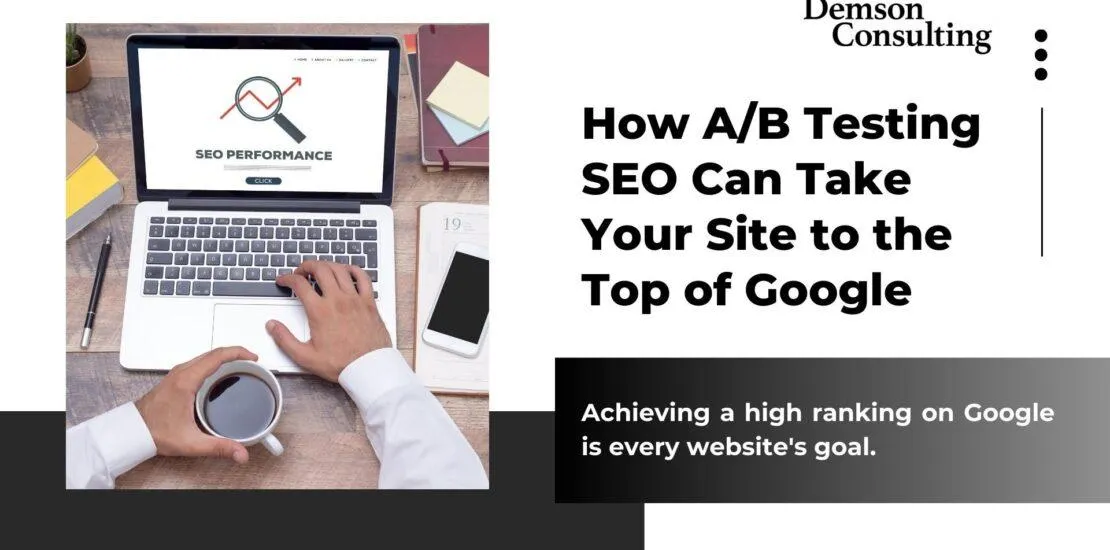Boost Your Lifetime Value (LTV) with Cash Multiplier Strategies
Maximize profitability by accelerating your customer's lifetime value.
How A/B Testing SEO Can Take Your Site to the Top of Google

Achieving a high ranking on Google is every website’s goal. After all, it’s the key to increasing organic traffic and visibility. One of the most effective techniques to boost your website’s SEO is A/B testing. A/B Testing SEO is a great way to make data-driven decisions that directly impact your website’s search performance.
A/B testing can help you make precise, informed changes to your website. Whether you are tweaking your page titles or refining your content, A/B testing SEO allows you to optimize your site to better meet Google’s algorithmic standards. In this blog post, we’ll dive deep into why A/B testing is so crucial for SEO success, how it works, and the steps to implement it effectively.
What is A/B Testing SEO?
A/B testing in SEO refers to comparing two versions of a webpage to evaluate which one performs better. This process allows you to experiment with different SEO strategies, such as title tags, meta descriptions, headings, and content formats, to see which combination attracts more traffic from search engines like Google.
In a typical A/B test, you create two versions of a page (A and B). Version A is your current page, and version B contains the changes you want to test. You then split your website traffic evenly between both versions, tracking key metrics like click-through rates, bounce rates, and engagement to determine which page is more successful. Thus, A/B testing is one of the most effective ways to optimize your site because it provides real data on what works.
Why A/B Testing SEO is Crucial for Google Rankings?
– Improves SEO Performance
A/B testing helps you fine-tune individual SEO components that contribute to your site’s ranking on Google. For example, you might test different meta descriptions to see which one leads to higher click-through rates. Because click-through rate is a ranking factor for Google, the version with the higher CTR could help improve your position on the search engine results pages (SERPs).
Furthermore, A/B testing helps you identify which content types, keyword placements, or site structures are most effective for ranking. By optimizing these elements based on real data, you ensure that your website is not only meeting Google’s expectations but exceeding them.
– Increases User Engagement
When A/B testing is done correctly, you’re not just aiming to improve rankings; you’re also aiming to provide a better user experience. Google favors pages that engage users by offering relevant content and easy navigation. For example, if an A/B test reveals that one layout keeps users on your page longer, this increased engagement could signal to Google that your page is valuable.
– Maximizes Your Return on Investment (ROI)
A/B testing SEO helps you get the most out of your SEO efforts. If you’re investing time and resources into improving your website’s SEO, you want to be sure it’s working. A/B testing ensures that the strategies you implement are effective, leading to higher ROI over time. It helps you make incremental improvements that result in long-term SEO success.
Key SEO Elements You Can A/B Test

Several key SEO elements can be tested through A/B testing. Here’s a detailed look at the most impactful elements to optimize:
1. Page Titles
The title tag of a webpage is one of the most important SEO elements. It’s what appears as the clickable headline in Google’s search results. By testing different versions of your title tags, you can find the most compelling combination of keywords that improve your rankings and click-through rate.
For example, you can test whether using a number in your title (e.g., “5 Best Ways to Improve SEO”) or a more descriptive approach (e.g., “How to Rank Higher on Google: Proven SEO Tips”) results in more clicks. Since title tags directly affect how search engines rank your page, optimizing this element can significantly improve your SEO performance.
2. Meta Descriptions
Meta descriptions provide a summary of your page’s content. Although meta descriptions don’t directly impact rankings, they play an important role in attracting users to click on your link from the search results. A/B testing different meta descriptions can help you create a concise, appealing message that drives more organic traffic to your website.
When testing meta-descriptions, experiment with variations in length, tone, and the inclusion of a call-to-action. A compelling meta description can significantly increase the likelihood of someone clicking on your page.
What We Offer

Strategic Brand Development
Your brand embodies more than mere aesthetics or words; it encapsulates how your offerings resonate with your...

ECommerce Growth & Innovation
The potential for your eCommerce growth knows no bounds. Let's craft a digital experience that drives loyalty...

Strategic Go-to-Market Planning for Product Launch
Your product launch is a pivotal moment, and precision is paramount. That's where we step in. Our go-to-market...

Strategic Growth Marketing Implementation
Are you ready for the next level of success? Let's collaborate on a comprehensive marketing strategy that seamlessly...

Data-Driven Performance Marketing Transformation
Unlock the potential of cutting-edge analytics and data-driven strategies with our customized performance marketing and...

Tailored Marketing Consulting
Demson Consulting offers flexible monthly retained consulting services tailored to your specific needs. Whether...
Unlock Your Business's Full Potential with Us!
We're thrilled to embark on this journey with you and bring your business's top-to-bottom potential to life. Let's connect and make magic happen.
3. Headlines (H1, H2, H3)
Headlines are critical for both SEO and user experience. The H1 tag often serves as the main heading for a page, while the H2 and H3 tags organize the content into logical sections. A/B testing different headline versions can help you identify which ones better capture users’ attention and improve engagement. Furthermore, using keywords naturally within your headlines can give your SEO an extra boost.
4. Content Layout
The way your content is structured and presented impacts how users interact with your website. A well-structured page that is easy to read and visually appealing is more likely to reduce bounce rates and increase time on site. A/B testing different content layouts, such as variations in image placement, text size, and call-to-action buttons, can help you find the most effective structure for your audience.
5. Internal Linking
Internal links help Google understand the structure of your website. They also pass “link juice” or authority between pages. By testing different internal linking strategies, you can optimize how link equity is distributed across your website. For example, A/B testing can help you identify which links improve crawlability and the overall SEO of your site.
Steps to Perform A/B Testing SEO
To carry out effective A/B testing for SEO, follow these simple steps:
1. Define Clear Goals
Before you begin testing, clearly define what you hope to achieve. Are you aiming to improve click-through rates, reduce bounce rates, or increase conversion rates? By setting specific goals, you’ll be able to focus on the key areas of your website that require optimization.
2. Choose the Right Variables
Pick one or two SEO elements to test. Testing too many variables at once can skew your results. Focus on testing one element, such as the page title or meta description, so you can pinpoint which changes contributed to the improvement.
3. Split Your Traffic
Once you’ve decided what you’ll be testing, split your website traffic evenly between the two variations (A and B). This ensures that each version of your page gets a fair amount of exposure, leading to more accurate results.
4. Monitor and Measure Results
After running your test, carefully monitor the results. Analyze metrics like click-through rate (CTR), bounce rate, average time on page, and conversion rate. These metrics will help you determine which version of the page is performing better.
5. Implement the Winning Version
Once you have a clear winner, implement the changes across your website. The version that outperformed the other should be used as the permanent version. However, A/B testing is an ongoing process. Continuously test and optimize your SEO strategies for long-term success.
Common A/B Testing Mistakes to Avoid
While A/B testing SEO is a powerful technique, there are a few mistakes you should avoid:
☑️ Testing Too Many Variables at Once: Trying to test multiple changes in one go can make it hard to pinpoint what exactly caused the results. Always focus on testing just one or two elements at a time.
☑️ Not Running Tests Long Enough: Some tests may not provide accurate results if they run for too short a period. Make sure you allow enough time for your test to gather sufficient data—usually at least one to two weeks.
☑️ Ignoring Statistical Significance: Ensure your results are statistically significant before implementing changes. Without proper analysis, you could make changes based on unreliable data, which could negatively impact your SEO performance.
The Bottom Line
A/B testing SEO is a game-changer for improving your Google rankings. By testing different SEO elements, you can make data-driven decisions that enhance your website’s performance. Whether you’re tweaking your page titles, content layout, or internal linking, A/B testing allows you to optimize your site continuously. Start implementing A/B testing today and watch your SEO strategy improve over time.
Ready to improve your website’s SEO? Start A/B testing today and discover how small changes can lead to significant results. Contact Demson Consulting now for expert SEO guidance and assistance with A/B testing to maximize your website’s potential.
Frequently Asked Questions
1. How long does an A/B test for SEO take?
An A/B test typically takes at least one to two weeks to gather enough data for reliable results. However, the length can vary depending on your website’s traffic.
2. Can A/B testing improve my website’s user experience?
Yes, A/B testing can help improve user experience by optimizing elements like layout, content, and navigation, which can lead to better engagement and reduced bounce rates.
3. Do I need to be an expert to perform A/B testing for SEO?
No, there are many user-friendly tools available that make A/B testing accessible to anyone, regardless of technical expertise.
Leave a Reply
© Copyright 2025. Mike Demson. All Rights Reserved.

